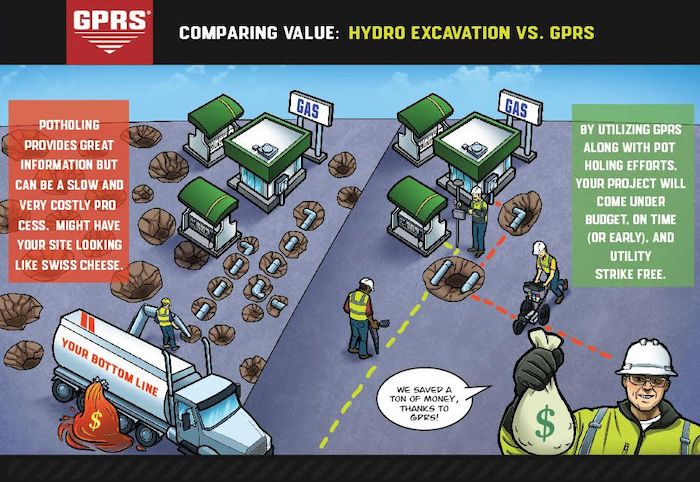If Seeing is Believing, Potholing May Be Your Best Bet. But At What Cost?
How to Reduce Your Inspection Costs by Reducing Your Use of Potholing
Potholing is an established technique to ensure safety before excavation and is widely adopted across construction processes. Countless professionals consider it the most reliable approach to accurately identify what lies beneath the surface of a worksite.
Let’s explore the benefits and drawbacks of this method, as well as alternative methods to minimize the expense and duration of digging.

Reduce Your Inspection Costs By Reducing Your Use Of Potholing
What is Utility Potholing?
Utility potholing is a commonly used method to locate utility lines during construction, repairs, or other underground work. A portable vacuum excavator, using either air or water to extract the dirt from the ground, is utilized instead of manual excavators such as shovels or backhoes.
Although potholing is one of the best and most accurate ways to verify what's underground, it's time-consuming, expensive, and possibly risky. A single job requiring potholing to dig 15-25 holes can last for weeks and cost tens of thousands of dollars. In addition to this, it involves various permits and environmental concerns that must be approved and taken into consideration.
But you have options.
Potholing is not the only way to get underground visibility. GPRS offers an incredibly viable alternative to potholing. By creating their own proprietary training certification process, covering a multitude of various testing methods and tools, they have removed many barriers from the equation. The result is an underground visibility service provided by their highly-trained project managers, leveraging a mix of analysis methods, delivering a 99.8% accuracy rating.
With GPRS, you can bypass the traditionally excessive potholing, saving you time, money, and hassle, without compromising on accuracy or technical expertise.
How do alternative sub-surface analysis methods compare to potholing?
Here’s an example of how potholing compares to GPRS’ Subsurface Investigation Methodology (SIM) approach.
Potholing is a much more complicated process, involving more people and equipment that takes up more of your time.
People and Equipment Required:
- Hydrovac Unit and Operator
- Additional Labor may be necessary
- Remote Pipe may be necessary
- Support Truck may be necessary
Services Performed:
- Saw cut pavement if required
- Perform necessary hydro evacuation process
- Backfill the hole
- Cold patch the hole
- Dispose of all ground waste properly
- Overnight stay may be necessary
- Mobilization and demobilization
- Environmental cleanup
This all adds up to a cost of about $8,775 per day.
And on top of that, your site is now riddled with patch marks.
Potholing crews normally manage around eight holes per day, but at times when sites need over 20, the costs and delays add up significantly.
By contrast, using the GPRS SIM approach takes just a day, and digging is mostly unnecessary. Our aboveground equipment ensures site preservation and safety, while our 99.8% accuracy rating provides precise and reliable results. Trust us to deliver an authoritative technical solution to all your sales needs.
How should you determine which path is right for your application?
When it comes to subsurface analysis of your next dig project, there are two alternatives to just potholing as an investigative technique:
- GPRS SIM Process to reduce potholing costs. We can work in conjunction with a potholing company if your project mandates that potholing be used to verify underground hazards.
- GPRS SIM Process as a full 99.8% accurate potholing alternative. If potholing is not required but encouraged, we provide an incredibly accurate alternative that wouldn’t require potholing at all, cutting your project costs and timeline by over 90%.
Note: GPRS does not provide geophysical, geological, land surveying or engineering services. If you need such services, please contact an appropriate professional.
SIM is one of the building blocks of how we Visualize The Built World™ for our customers. What can we help you visualize?
